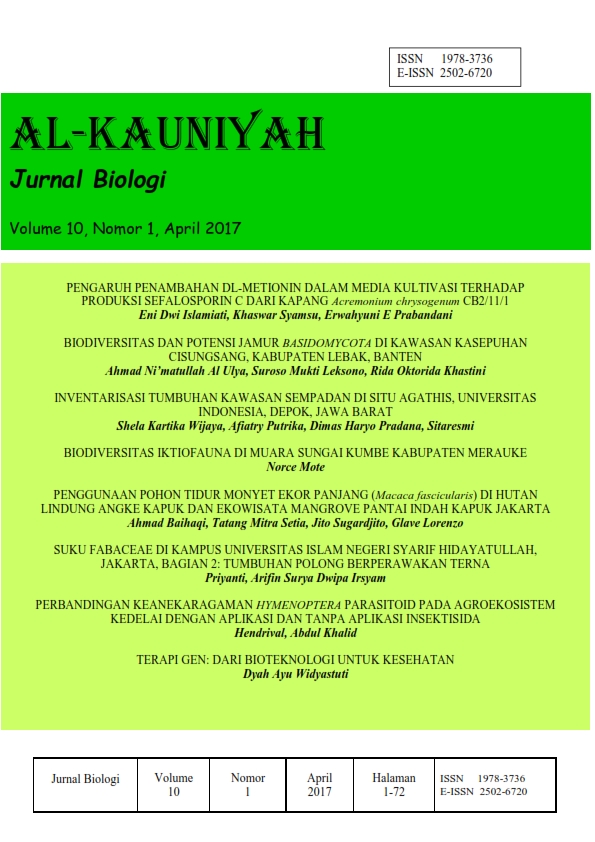PERBANDINGAN KEANEKARAGAMAN HYMENOPTERA PARASITOID PADA AGROEKOSISTEM KEDELAI DENGAN APLIKASI DAN TANPA APLIKASI INSEKTISIDA
DOI:
https://doi.org/10.15408/kauniyah.v10i1.4899Keywords:
Hymenoptera parasitoid, Insektisida, Keanekaragaman, Kedelai, Diversity, Hymenoptera Parasitoids, Insecticide, SoybeanAbstract
Abstrak
Sistem pengelolaan tanaman kedelai dengan penggunaan insektisida sintetik yang intensif akan menurunkan keanekaragaman jenis Hymenoptera parasitoid. Penelitian bertujuan untuk memban-dingkan keanekaragaman Hymenoptera parasitoid pada agroekosistem kedelai dengan dan tanpa aplikasi insektisida sintetik. Pengumpulan data serangga menggunakan perangkap dari jaring serangga dan nampan kuning. Hasil penelitian menunjukkan bahwa indeks keanekaragaman jenis pada fase pertumbuhan vegetatif dan generatif kedelai dengan aplikasi insektisida lebih rendah dibandingkan dengan yang tanpa aplikasi insektisida, yang keduanya tergolong sedang. Indeks kemerataan jenis pada fase pertumbuhan vegetatif dan generatif dari kedua agroekosistem kedelai tergolong tinggi. Indeks kekayaan jenis pada fase vegetatif dari agroekosistem kedelai dengan aplikasi insektisida tergolong rendah (0<2,3955≤2,5), sedangkan pada fase generatif tergolong sedang (0<3,6118≤4). Indeks kekayaan jenis pada fase vegetatif (0<2,6229≤4) dan generatif (0<3,8287≤4) dari agroekosistem kedelai tanpa aplikasi insektisida tergolong sedang. Komunitas Hymenoptera parasitoid pada agroekosistem kedelai tanpa aplikasi insektisida memiliki kemiripan lebih rendah daripada yang dengan aplikasi insektisida. Aplikasi insektisida mempengaruhi indeks kekayaan jenis pada fase generatif dan kemiripan komunitasnya, yaitu nilainya lebih rendah daripada yang tanpa insektisida.
Abstract
The management system of soybean agroecosystem with an intensive use of synthetic insecticides will reduce the diversity of parasitoid Hymenoptera species. The study aimed to compare the diversity of the parasitoids in soybean agroecosystem with and without insecticide application. The collection of the parasitoid used insect net and yellow tray. The results showed that the diversity index of the parasitoids during vegetative and generative growth of the soybean with the insecticide application was lower than the one without the insecticide application, which both were classified as moderate. The evenness indices during vegetative and generative growth were high. The richness index in vegetative phase with insecticide application was classified as low (0<2.3955≤2.5), while in the generative phase was classified as moderate (0<3.6118≤4). The richness index on the vegetative (0<2.6229≤4) and generative (0<3.8287≤4) from the agroecosystem soybean without insecticide application were classified as moderate. The similarity without insecticide application was lower than the one with insecticide application. The application of insecticide affects the species richness index (in the generative phase) and the similarity, that the value is lower than the one without insecticide.
References
the subfamilies of the Braconidae (Hymenoptera: Ichneumonoidea). Zoologische Verhandelingen Leiden, 283, 1-189.
Austin, A.D., Johnson, N.F., & Downton, M. (2005). Systematics, evolution, and biology of scelionid and platygastrid wasps. Annual Review of Entomology, 50, 553-582. doi: 10.1146/annurev.ento. 50.071803.130500
Baliadi, Y., Tengkano, W., & Marwoto. (2008). Penggerek polong kedelai, Etiella zinckenella Treitschke (Lepidoptera: Pyralidae), dan strategi pengendaliannya di Indonesia. Jurnal Penelitian dan Pengembangan Pertanian, 27(4), 113-123.
Blibech, I., Ksantini, M., Jardak, T., & Bouaziz, M. (2015). Effect of insecticides on trichogramma parasitoids used in biological control against prays oleae insect pest. Advances in Chemical Engineering and Science, 5, 362-372. doi: 10.4236/aces.2015.53038
Dang, T.D., Luu, T.H.P., & Khuat, D.L. (2011). Insect parasitoid composition on soybean, some ecobiological characteristics of the parasiotoid, Xanthopimpla puncitata Fabrictus on soybean leaf folder Omiodes indicata (Fabricius) in Hanoi, Vietnam. Journal International Society for Southeast Asian Agricultural Sciences, 17(2), 58-69.
Fernandes, F.L., Bacci, L., & Fernandes, M.S. (2010). Impact and selectivity of insecticides to predators and parasitoids. EntomoBrasilis, 3(1), 01-10.
Frewin, A.J., Xue, Y., Welsman, J.A., Broadbent, A.B., Schaafsma, A.W., & Hallett, R.H. (2010). Development and parasitism by Aphelinus certus (Hymenoptera: Aphelinidae), a parasitoid of Aphis glycines (Hemiptera: Aphididae). Environmental Entomology, 39(5), 1570-1578. doi: org/10.1603/EN09312
Gibson, G.A.P., Read, J., & Huber, J.T. (2007). Diversity, classification and higher relationships of Mymarommatoidea (Hymenoptera). Journal of Hymenoptera Research, 16, 51-146.
Goulet, H. & Huber J.T. (Eds.). (1993). Hymenoptera of the world: An identification guide to families. Canada: Canada Communication Group Publishing.
Grissell, E.E. & Schauff, M.E. (1990). A handbook of the families of Nearctic Chalcidoidea (Hymenoptera).Washington, D. C.: Entomological Society of Washington.
Hamid, H. (2012). Struktur komunitas serangga herbivora dan parasitoid pada polong tanaman kacang-kacangan (Fabaceae) di Padang. Jurnal Entomologi Indonesia, 9(2), 88-94. doi: 10.5994/jei.9.2.88

